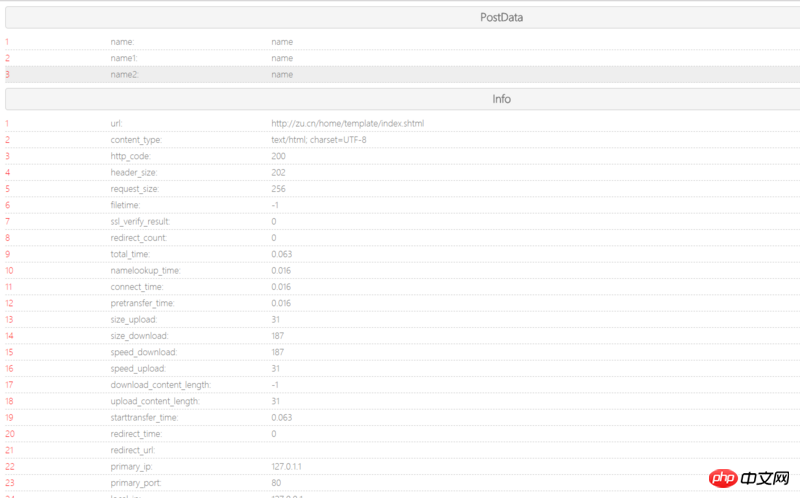封装的php cUrl请求函数
这篇文章主要介绍了关于封装的php cUrl请求函数,有着一定的参考价值,现在分享给大家,有需要的朋友可以参考一下
开启调试模式后


使用方法:
$params = [
'name'=>'name'
];
$url = '';
httpRequest($url,'POST',$params,[],true);/**
* CURL请求
* @param $url 请求url地址
* @param $method 请求方法 get post
* @param null $postfields post数据数组
* @param array $headers 请求header信息
* @param bool|false $debug 调试开启 默认false
* @return mixed
*/
function httpRequest($url, $method = "GET", $postfields = null, $headers = array(), $debug = false)
{
$method = strtoupper($method);
$ci = curl_init();
/* Curl settings */
curl_setopt($ci, CURLOPT_HTTP_VERSION, CURL_HTTP_VERSION_1_0);//版本
curl_setopt($ci, CURLOPT_USERAGENT, "Mozilla/5.0 (Windows NT 6.2; WOW64; rv:34.0) Gecko/20100101 Firefox/34.0");//在HTTP请求中包含一个"User-Agent: "头的字符串。
curl_setopt($ci, CURLOPT_CONNECTTIMEOUT, 60); /* 在发起连接前等待的时间,如果设置为0,则无限等待 */
curl_setopt($ci, CURLOPT_TIMEOUT, 7); /* 设置cURL允许执行的最长秒数 */
curl_setopt($ci, CURLOPT_RETURNTRANSFER, true);//将curl_exec()获取的信息以文件流的形式返回,而不是直接输出。
switch ($method) {
case "POST":
curl_setopt($ci, CURLOPT_POST, true);//启用时会发送一个常规的POST请求,类型为:application/x-www-form-urlencoded,就像表单提交的一样。
if (!empty($postfields)) {
$tmpdatastr = is_array($postfields) ? http_build_query($postfields) : $postfields;
curl_setopt($ci, CURLOPT_POSTFIELDS, $tmpdatastr);
}
break;
default:
curl_setopt($ci, CURLOPT_CUSTOMREQUEST, $method); /* //设置请求方式 */
break;
}
$ssl = preg_match('/^https:\/\//i', $url) ? TRUE : FALSE;
curl_setopt($ci, CURLOPT_URL, $url);//需要获取的URL地址,也可以在curl_init()函数中设置
if ($ssl) {
curl_setopt($ci, CURLOPT_SSL_VERIFYPEER, FALSE); // https请求 不验证证书和hosts
curl_setopt($ci, CURLOPT_SSL_VERIFYHOST, FALSE); // 不从证书中检查SSL加密算法是否存在
}
//curl_setopt($ci, CURLOPT_HEADER, true); /*启用时会将头文件的信息作为数据流输出*/
curl_setopt($ci, CURLOPT_FOLLOWLOCATION, 1);
curl_setopt($ci, CURLOPT_MAXREDIRS, 2);/*指定最多的HTTP重定向的数量,这个选项是和CURLOPT_FOLLOWLOCATION一起使用的*/
curl_setopt($ci, CURLOPT_HTTPHEADER, $headers);
curl_setopt($ci, CURLINFO_HEADER_OUT, true);
/*curl_setopt($ci, CURLOPT_COOKIE, $Cookiestr); * *COOKIE带过去** */
$response = curl_exec($ci);
$requestinfo = curl_getinfo($ci);
if ($debug) {
$html = <<<HTML
<style>
*{
margin:0;
padding:0;
font-family: "微软雅黑 Light";
color:#777;
}
body{
padding:10px;
}
h1{
border:1px solid #CCCCCC;
height: 40px;
line-height: 40px;
font-size: 20px;
border-radius: 5px;
text-align: center;
background: #F5F5F5;
}
p.box{
padding:10px 0;
}
p.line{
height: 30px;
line-height: 30px;
border-bottom: 1px dashed #ccc;
overflow: auto;
}
p.line:hover{
background: #EEEEEE;;
}
span.title{
display: inline-block;
width:300px;
height: 100%;
}
span.key{
color:red;
display: inline-block;
width:200px;
height: 100%;
}
</style>
<h1>PostData</h1>
<p class="box">
HTML;
$i = 1;
foreach ($postfields as $key => $value) {
$html .= " <p class=\"line\"><span class='key'>{$i}</span><span class=\"title\">{$key}:</span> <span>{$value}</span></p>";
$i++;
}
$html .= <<<HTML
</p>
<h1>Info</h1>
<p class="box">
HTML;
$i = 1;
foreach ($requestinfo as $kye => $value) {
if (is_array($value)) continue;
$html .= " <p class=\"line\"><span class='key'>{$i}</span><span class=\"title\">{$kye}:</span> <span>{$value}</span></p>";
$i++;
}
$html .= <<<HTML
</p>
<h1>Response</h1>
<p class="box">
{$response}
</p>
<p>
HTML;
$html .= <<<HTML
</p>
HTML;
echo $html;
}
curl_close($ci);
return $response;
}相关推荐:
以上是封装的php cUrl请求函数的详细内容。更多信息请关注PHP中文网其他相关文章!

热AI工具

Undresser.AI Undress
人工智能驱动的应用程序,用于创建逼真的裸体照片

AI Clothes Remover
用于从照片中去除衣服的在线人工智能工具。

Undress AI Tool
免费脱衣服图片

Clothoff.io
AI脱衣机

Video Face Swap
使用我们完全免费的人工智能换脸工具轻松在任何视频中换脸!

热门文章

热工具

记事本++7.3.1
好用且免费的代码编辑器

SublimeText3汉化版
中文版,非常好用

禅工作室 13.0.1
功能强大的PHP集成开发环境

Dreamweaver CS6
视觉化网页开发工具

SublimeText3 Mac版
神级代码编辑软件(SublimeText3)
 适用于 Ubuntu 和 Debian 的 PHP 8.4 安装和升级指南
Dec 24, 2024 pm 04:42 PM
适用于 Ubuntu 和 Debian 的 PHP 8.4 安装和升级指南
Dec 24, 2024 pm 04:42 PM
PHP 8.4 带来了多项新功能、安全性改进和性能改进,同时弃用和删除了大量功能。 本指南介绍了如何在 Ubuntu、Debian 或其衍生版本上安装 PHP 8.4 或升级到 PHP 8.4
 我后悔之前不知道的 7 个 PHP 函数
Nov 13, 2024 am 09:42 AM
我后悔之前不知道的 7 个 PHP 函数
Nov 13, 2024 am 09:42 AM
如果您是一位经验丰富的 PHP 开发人员,您可能会感觉您已经在那里并且已经完成了。您已经开发了大量的应用程序,调试了数百万行代码,并调整了一堆脚本来实现操作
 如何设置 Visual Studio Code (VS Code) 进行 PHP 开发
Dec 20, 2024 am 11:31 AM
如何设置 Visual Studio Code (VS Code) 进行 PHP 开发
Dec 20, 2024 am 11:31 AM
Visual Studio Code,也称为 VS Code,是一个免费的源代码编辑器 - 或集成开发环境 (IDE) - 可用于所有主要操作系统。 VS Code 拥有针对多种编程语言的大量扩展,可以轻松编写
 在PHP API中说明JSON Web令牌(JWT)及其用例。
Apr 05, 2025 am 12:04 AM
在PHP API中说明JSON Web令牌(JWT)及其用例。
Apr 05, 2025 am 12:04 AM
JWT是一种基于JSON的开放标准,用于在各方之间安全地传输信息,主要用于身份验证和信息交换。1.JWT由Header、Payload和Signature三部分组成。2.JWT的工作原理包括生成JWT、验证JWT和解析Payload三个步骤。3.在PHP中使用JWT进行身份验证时,可以生成和验证JWT,并在高级用法中包含用户角色和权限信息。4.常见错误包括签名验证失败、令牌过期和Payload过大,调试技巧包括使用调试工具和日志记录。5.性能优化和最佳实践包括使用合适的签名算法、合理设置有效期、
 php程序在字符串中计数元音
Feb 07, 2025 pm 12:12 PM
php程序在字符串中计数元音
Feb 07, 2025 pm 12:12 PM
字符串是由字符组成的序列,包括字母、数字和符号。本教程将学习如何使用不同的方法在PHP中计算给定字符串中元音的数量。英语中的元音是a、e、i、o、u,它们可以是大写或小写。 什么是元音? 元音是代表特定语音的字母字符。英语中共有五个元音,包括大写和小写: a, e, i, o, u 示例 1 输入:字符串 = "Tutorialspoint" 输出:6 解释 字符串 "Tutorialspoint" 中的元音是 u、o、i、a、o、i。总共有 6 个元
 您如何在PHP中解析和处理HTML/XML?
Feb 07, 2025 am 11:57 AM
您如何在PHP中解析和处理HTML/XML?
Feb 07, 2025 am 11:57 AM
本教程演示了如何使用PHP有效地处理XML文档。 XML(可扩展的标记语言)是一种用于人类可读性和机器解析的多功能文本标记语言。它通常用于数据存储
 解释PHP中的晚期静态绑定(静态::)。
Apr 03, 2025 am 12:04 AM
解释PHP中的晚期静态绑定(静态::)。
Apr 03, 2025 am 12:04 AM
静态绑定(static::)在PHP中实现晚期静态绑定(LSB),允许在静态上下文中引用调用类而非定义类。1)解析过程在运行时进行,2)在继承关系中向上查找调用类,3)可能带来性能开销。
 什么是PHP魔术方法(__ -construct,__destruct,__call,__get,__ set等)并提供用例?
Apr 03, 2025 am 12:03 AM
什么是PHP魔术方法(__ -construct,__destruct,__call,__get,__ set等)并提供用例?
Apr 03, 2025 am 12:03 AM
PHP的魔法方法有哪些?PHP的魔法方法包括:1.\_\_construct,用于初始化对象;2.\_\_destruct,用于清理资源;3.\_\_call,处理不存在的方法调用;4.\_\_get,实现动态属性访问;5.\_\_set,实现动态属性设置。这些方法在特定情况下自动调用,提升代码的灵活性和效率。






